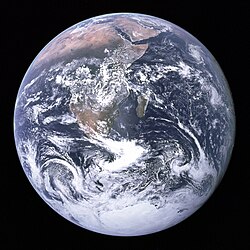Earth
Earth is the third planet from the Sun and the only astronomical object known to harbor life. According to radiometric dating and other sources of evidence, Earth formed over 4.5 billion years ago. Earth's gravity interacts with other objects in space, especially the Sun and the Moon, Earth's only natural satellite. Earth revolves around the Sun in 365.26 days, a period known as an Earth year. During this time, Earth rotates about its axis about 366.26 times.[1]


Earth’s magnetic field is generated by rotation and the outer liquid core. It rotates once in about 24 hours with respect to the Sun, but every 23 hours, 56 minutes and 4 seconds with respect to other, distant stars, Earth’s rotation is slowing slightly with time, thus a day was shorter in the past. The planet rotates eastward, in prograde motion around its axis, and rotates counterclockwise, as viewed from the pole star Polaris.
